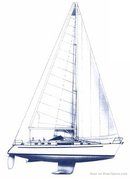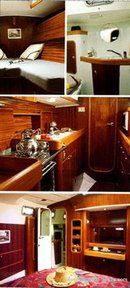Océanis 44 CC
Sailboat specifications
The Océanis 44 CC is a 44’ (13.4m) cruising sailboat designed by Farr Yacht Design (United States). She was built between 1993 and 2002 by Bénéteau (France).
Océanis 44 CC's main features
- Model
- Océanis 44 CC
- Hull type
- Monohull
- Category
- Offshore cruising sailboat
- Sailboat builder
- Sailboat designer
- Sailboat range
- Country
- France
- Construction
- Hull and deck: GRP (glass reinforced polyester)
- Number of hulls built
- About 150
- First built hull
- 1993
- Last built hull
- 2002
- Appendages
- Keel : L-shaped keel (with bulb)
- Helm
- Single helm wheel
- Rudder
- Single spade rudder
- Unsinkable
- No
- Trailerable
- No
- Former French navigation category
- 1
- Standard public price ex. VAT (indicative only)
- N/A €
Océanis 44 CC's main dimensions
- Overall length
- 44’ 7”13.6 m
- Hull length
- 44’13.4 m
- Waterline length
- 36’ 8”11.2 m
- Beam (width)
- 13’ 11”4.25 m
- Draft
- 5’ 8”1.75 m
- Light displacement (MLC)
- 23369 lb10600 kg
- Ballast weight
- 6834 lb3100 kg
- Ballast type
- Cast iron
- French customs tonnage
- 21.30 Tx
Océanis 44 CC's rig and sails
- Upwind sail area
- 1098 ft²102 m²
- Downwind sail area
- 1636 ft²152 m²
- Mainsail area
- 452 ft²42 m²
- Genoa area
- 646 ft²60 m²
- Symmetric spinnaker area
- 1184 ft²110 m²
- IiFore triangle height (from mast foot to fore stay top attachment)
- 46’ 1”14.06 m
- JiFore triangle base (from mast foot to bottom of forestay)
- 17’ 7”5.35 m
- PiMainsail hoist measurement (from tack to head)
- 52’ 5”15.97 m
- EiMainsail foot measurement (from tack to clew)
- 16’ 4”4.97 m
- Rigging type
- Sloop Marconi (in-mast furling mainsail) masthead
- Mast configuration
- Keel stepped mast
- Rotating spars
- No
- Number of levels of spreaders
- 2
- Spreaders angle
- 18 °
- Spars construction
- Aluminum spars
- Standing rigging
- 1x19 strand wire discontinuous
Océanis 44 CC's performances
- Upwind sail area to displacementiThe ratio sail area to displacement is obtained by dividing the sail area by the boat's displaced volume to the power two-thirds.
The ratio sail area to displacement can be used to compare the relative sail plan of different sailboats no matter what their size.
Upwind: under 18 the ratio indicates a cruise oriented sailboat with limited performances especially in light wind, while over 25 it indicates a fast sailboat. - 228 ft²/T21.14 m²/T
- Downwind sail area to displacementiThe ratio sail area to displacement is obtained by dividing the sail area by the boat's displaced volume to the power two-thirds.
The ratio sail area to displacement can be used to compare the relative sail plan of different sailboats no matter what their size. - 339 ft²/T31.5 m²/T
- Displacement-length ratio (DLR)iThe Displacement Length Ratio (DLR) is a figure that points out the boat's weight compared to its waterline length. The DLR is obtained by dividing the boat's displacement in tons by the cube of one one-hundredth of the waterline length (in feet).
The DLR can be used to compare the relative mass of different sailboats no matter what their length:
a DLR less than 180 is indicative of a really light sailboat (race boat made for planning), while a DLR greater than 300 is indicative of a heavy cruising sailboat. - 214
- Ballast ratioiThe Ballast ratio is an indicator of stability; it is obtained by dividing the boat's displacement by the mass of the ballast. Since the stability depends also of the hull shapes and the position of the center of gravity, only the boats with similar ballast arrangements and hull shapes should be compared.
The higher the ballast ratio is, the greater is the stability. - 29 %
- Critical hull speediAs a ship moves in the water, it creates standing waves that oppose its movement. This effect increases dramatically the resistance when the boat reaches a speed-length ratio (speed-length ratio is the ratio between the speed in knots and the square root of the waterline length in feet) of about 1.2 (corresponding to a Froude Number of 0.35) . This very sharp rise in resistance, between speed-length ratio of 1.2 to 1.5, is insurmountable for heavy sailboats and so becomes an apparent barrier. This leads to the concept of "hull speed".
The hull speed is obtained by multiplying the square root of the waterline length (in feet) by 1.34. - 8.12 knots
Océanis 44 CC's auxiliary engine
- Engine(s)
- 1 inboard engine
- Engine(s) power
- 80 HP
- Fuel type
- Diesel
- Fuel tank capacity
- 72.6 gal275 liters
Océanis 44 CC's accommodations and layout
- Cockpit
- Center cockpit
- Cabin(s) (min./max.)
- 2 / 3
- Berth(s) (min./max.)
- 4 / 8
- Head(s)
- 2
- Freshwater tank capacity
- 159.8 gal605 liters
- Boiler capacity
- 10 gal38 liters
- Maximum headroom
- 6’ 5”1.95 m
Océanis 44 CC's fore cabin
- Berth length
- 6’ 7”2 m
- Berth width
- 4’ 11”1.5 m
Océanis 44 CC's aft cabin
- Berth length
- 6’ 7”2 m
- Berth width
- 4’ 11”1.5 m



Bénéteau Océanis 44 CC sailplan - - 2/9
Picture extracted from the commercial documentation © Bénéteau
Picture extracted from the commercial documentation © Bénéteau




Bénéteau Océanis 44 CC cockpit - - 5/9
Picture extracted from the commercial documentation © Bénéteau
Picture extracted from the commercial documentation © Bénéteau


Bénéteau Océanis 44 CC interior and accommodations - - 6/9
Picture extracted from the commercial documentation © Bénéteau
Picture extracted from the commercial documentation © Bénéteau


Bénéteau Océanis 44 CC interior and accommodations - - 7/9
Picture extracted from the commercial documentation © Bénéteau
Picture extracted from the commercial documentation © Bénéteau


Bénéteau Océanis 44 CC interior and accommodations - - 8/9
Picture extracted from the commercial documentation © Bénéteau
Picture extracted from the commercial documentation © Bénéteau

Similar sailboats that may interest you:
Sailboats
First built hull
Hull length
2002
40’ 8”12.4 m
2012
41’ 5”12.61 m
2007
44’ 6”13.57 m
2010
44’ 7”13.6 m
2014
44’ 7”13.6 m
1995
45’ 1”13.76 m
1978
45’ 4”13.8 m
1989
45’ 4”13.8 m
1988
52’ 6”16 m
2016
44’ 11”13.68 m
2015
40’ 8”12.4 m
1995
45’ 1”13.76 m
2000
52’ 6”16 m
2017
50’ 11”15.51 m
1995
39’ 4”11.98 m